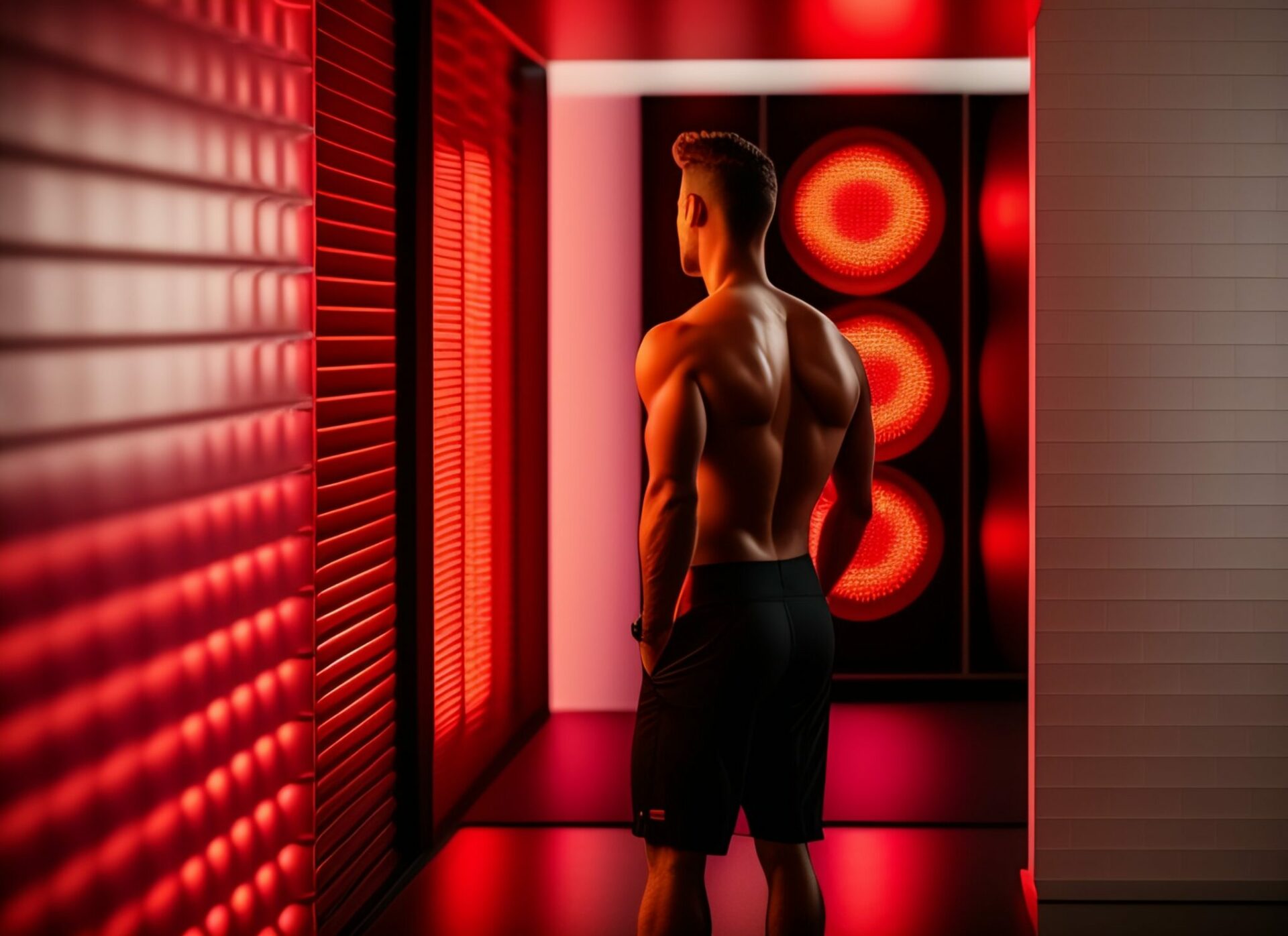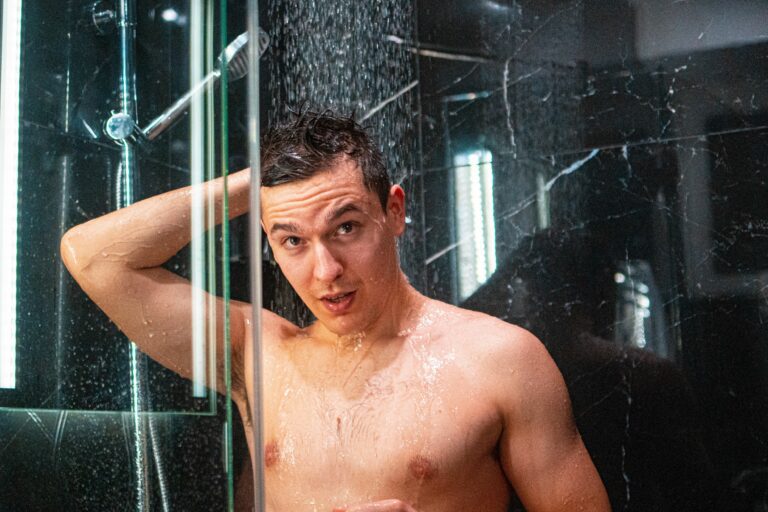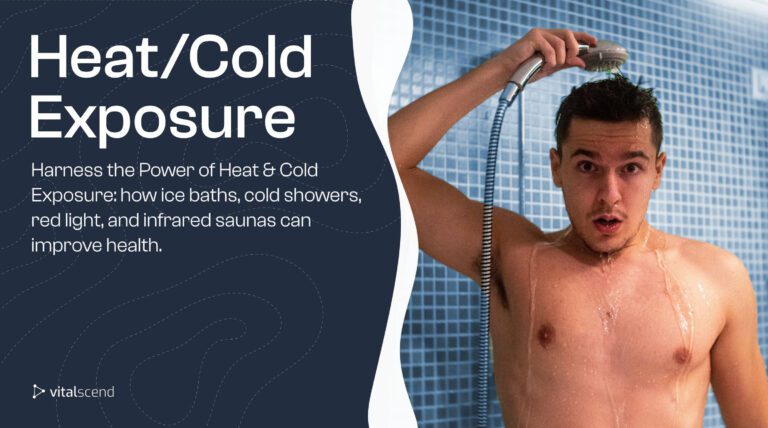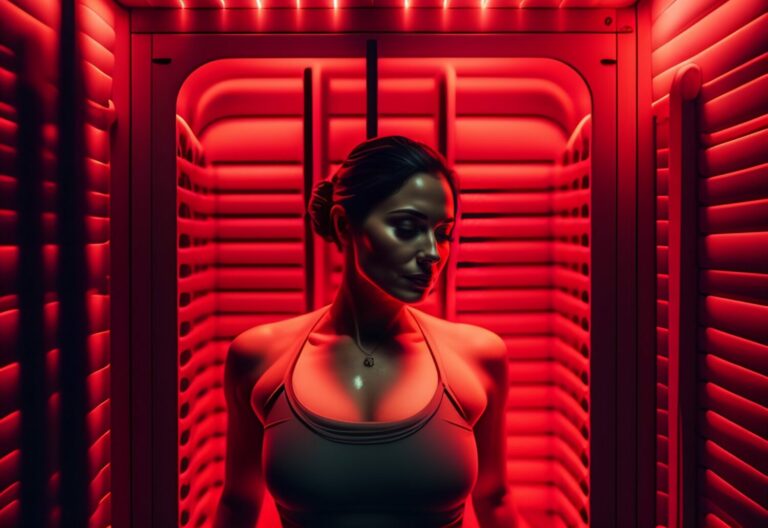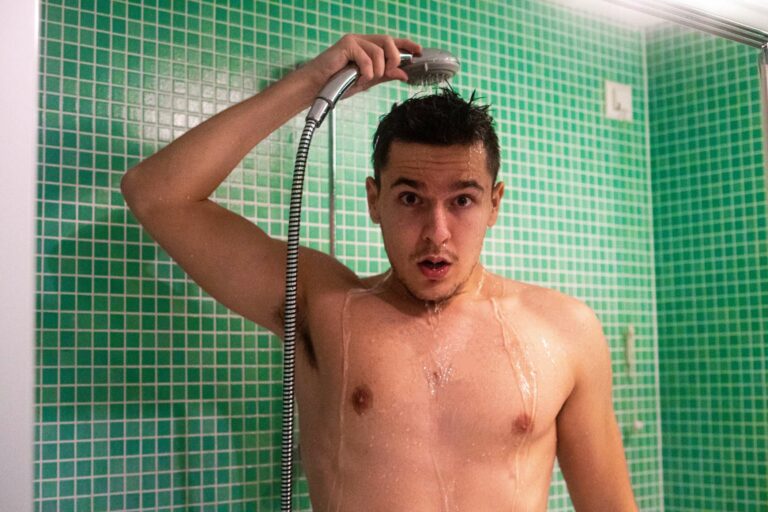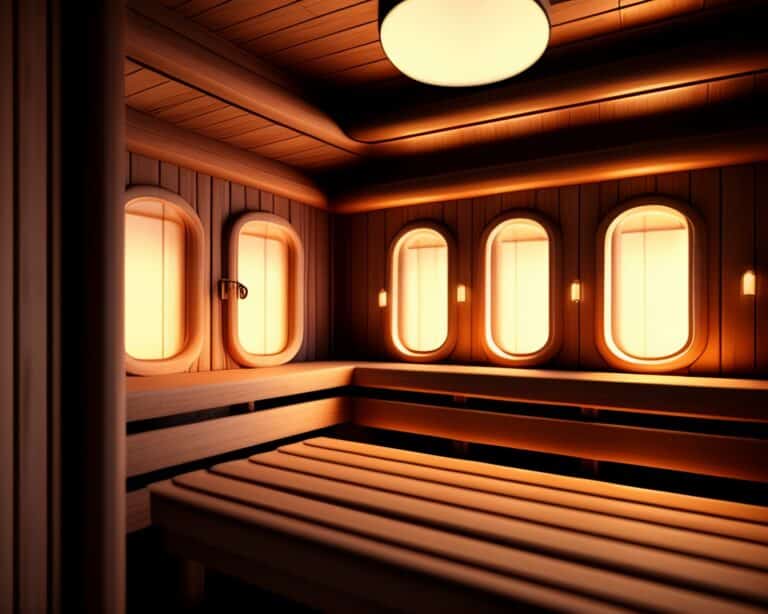Top 6 Benefits of Red Light Therapy: Skin Repair, Muscle Recovery, and Anti-Aging
Hacking your biology with the use of red light seems over the top, doesn’t it? The benefits of red light therapy are impressive, and the mechanisms behind it are mind-blowing. Red light boosts mitochondrial function which can improve skin repair, anti-aging, accelerate muscle growth and recovery, and act anti-inflammatory. Ready to dive in? Let’s go.
Biohacking Red Light
How to Improve Your Skin, Muscles, and Aging
Red light therapy can be one of the most interesting biohacks we’ve come across. Whether an infrared sauna or red light panels, it is a natural and non-invasive way that may enhance performance and health. Red light penetrates 5 mm deep into our skin and does its magic. It can enhance the way our body produces hormones, fights inflammation, and repairs tissue, especially skin and connective tissue.
Red Light Wavelength
You’ve probably heard of blue light, yellow light, or infrared light right? Each of them falls in a certain wavelength range or a band that is defined by the length of that light in nanometers. We can only see a certain spectrum of light, called the optical spectrum which captures light from 380 to 750 nanometers.
| Type of Light | Wavelength | Intensity |
| ultraviolet (UV) light | 100 – 400 nm | very high |
| violet light | 400 and 500 nm | high |
| blue light | 450 – 500 nm | medium |
| yellow/orange light | 570 – 630 nm | medium |
| red light | 620 to 700 nm | low |
| infrared light | 700 – 850 nm | very low |
Red light has wavelengths between 620 to 700 nm, and the shorter ones will be more powerful. Above 700, up to 850 nm or 1 mm comes infrared light, also popular for its use in skin repair, relaxation, circulation, and detox. We can’t capture all infrared light with our optical spectrum, but we can feel it as heat.
Can red light therapy burn your skin?
Red light therapy is likely safe unless misused. Skin burns or blisters have occurred due to long or too much exposure to red light, for example, if someone fell asleep during red light exposure.
Will red light therapy help with arthritis?
Red light therapy can help with arthritis pain because it reduces inflammation, one of the main problems in arthritis. RLT may also reduce arthritic pain, and improve mitochondrial function.
Will red light therapy tighten skin?
Yes. Some data suggests RLT’s potential use in improving skin complexity, collagen production, and most importantly skin repair and wound healing.
History of Red Light
As fancy as all the red-light emitting devices look, you’ll be blown away to learn that red light is produced by the sun, and our ancestors took advantage of it. The best way to get red light through the sun is exposure during the morning at sunrise or evening, during sunset.
Chromotherapy, which is a treatment of electromagnetic radiation that uses colors of our visible spectrum, has been widely used in ancient times by Egyptians. (1) How did they know it back then? I have no idea.
The point is, this isn’t a new practice. Color or light medicine dates way back, and there probably is a reason it helped with the healing. Maybe our ancestors didn’t know it increase ATP production by the mitochondria once it penetrated 5mm, but they felt it helped, so they used it.
During 1980-1990s Red light was studied for its use in biosynthesis, plant growth, photosynthesis, and potential effects on wound healing, radiation side effects reduction, wound healing, and muscle regeneration by NASA. (2) (3)
Red Light Therapy (RLT)
Red Light Therapy or RLT refers to the practical application of or exposure to red light (620 – 700 nm) for its potential benefits on skin repair, muscle regeneration, and potent anti-inflammatory properties.
RLT is a popular treatment promoted in many fitness facilities, health resorts, and spa & wellness centers. From small and portable, laser-like looking devices and window-like heavy red emitting LED devices up to full-body capsules or 360 RLT beds, you can find everything.
The most common alternative term for red light therapy used interchangeably is photobiomodulation. Biohackers love it. You can also find LLLT which stands for low-level laser light therapy, or soft laser therapy and photonic stimulation.
How Red Light Therapy Works
To understand how red light therapy works, we first have to understand what are mitochondria and how they function. Mitochondria are your power generators, they produce ATP. ATP is a chemical energy we obtain from food breakdown, which we use to function.
Optimizing mitochondria function is the primary mechanism behind how red light therapy can enhance our health and performance. It penetrates deep into our skin and promotes mitochondria function, stimulating proliferation, or cellular homeostasis. Our mitochondria soak this red light and use it to produce more ATP, repair itself, and even fight inflammation.
RLT can also stimulate the production of hormones, and help with cortisol and adrenaline production, as well as synthesizing DHEA, an important sex-hormones precursor.
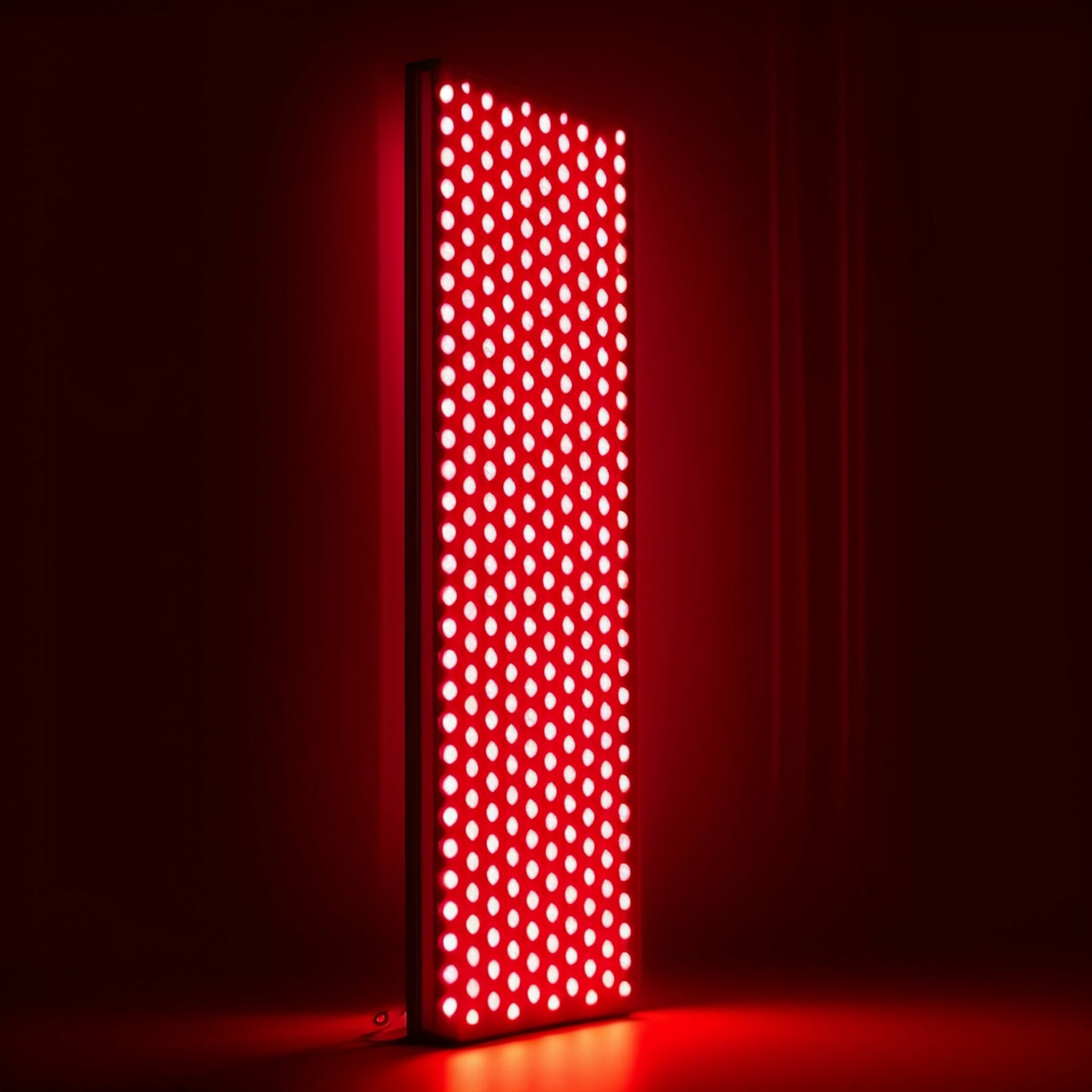
Hormesis: The Magic of Hormetic Stress
Red light therapy aims to stimulate hormesis, which is the evolutionary mechanism by which we adapt to survive. It happens when a low-dose stressor is applied, to stimulate a stronger response.
Low-intensity light therapy can provide even more reactive oxygen species (that cause inflammation) in some cells, which might promote proliferation and enhance their antioxidant mechanisms. This helps your cells create more energy to regenerate and restore redox homeostasis. (4)
What is the difference between red light and near-infrared light?
Red light has wavelengths of 620 to 700 nm, and the shorter ones will be more powerful. Above 700, up to 850 nm or 1 mm comes infrared light, also popular for its use in skin repair, relaxation, circulation, and detox. Red light is slightly more intense, and some infrared light is out of our optical spectrum, meaning we can’t see it but we can feel the heat.
What is red light therapy good for?
Red light therapy can be good for skin repair and wound healing, muscle recovery, joint pain reduction, regeneration, reducing inflammation, anti-aging, increasing energy, and optimizing performance.
Can red light therapy improve skin look?
Yes, infrared and red light have been shown to improve skin regeneration and wound healing. It is likely effective for reducing wrinkles and healing scars or stretch marks. It can also boost collagen production and improve skin tone.
Top 6 Benefits of Red Light Therapy
Red light therapy has been mainly used for wound healing, skin repair, and anti-aging. The use of red light has also shown some potential in other areas as well, like eye protection, pain and inflammation reduction, and muscle recovery. Some of these benefits are backed by strong research, and some are potential effects, but let’s see the underlying mechanisms behind.
Skin Repair and Wound Healing
As we’ve seen red light can optimize mitochondrial function. This helps our power-generating cells create more energy, which can lead to cell proliferation and differentiation. This means producing newer skin cells, to repair and replace damaged ones.
Red light therapy may improve and modulate different cellular processes to improve skin fibrosis, common for many dermatologic conditions. (5)
LLLT or Low-level laser therapy has also been used long for the reduction of acne scars, skin tissue damage, wrinkles or aging, and skin burns. Red light can stimulate nitric oxide release, resulting in improved circulation which allows skin cells to regenerate and repair. (6)
Low-power light therapy has also been shown to increase the proliferation of fibroblasts, which plays a major role in connective tissue repair. It can also reduce pain and skin inflammation and stimulate angiogenesis which is the formation of blood vessels. (7)
Improves Muscle Recovery
It is undeniable that red light made it to the fitness world. It’s not just injury recovery, it’s muscle growth that RL can improve too. By simply allowing better mitochondria function, it consequentially improves oxygenation which leads to better physical performance, as more energy is produced.
In strength training, photobiomodulation was proven to be an effective tool to enhance muscle growth as total mass gained was increased with RL after training. It also helps with recovery, as it reduces inflammation and oxidative stress. (8)
Another 2015 study showed that low-level laser and LED therapy improved exercise performance and power outputs. The application of infrared and red light before exercise also accelerated recovery from training. (9)
Phototherapy before exercise improves strength performance and gains. Also, phototherapy may provide extra benefits during the rehabilitation phase, post-injury. (10)
Photobiomodulation may also have the potential to improve DHEA synthesis, an important precursor of sex hormones. There is research backing some of Red Light’s positive effects on fertility and sexual function, but a direct DHEA or Testosterone link isn’t that frequently supported, yet. (11) If it is true though, we know how can Testosterone improve muscle growth and regeneration.
As posted in Rogue, the link between testosterone boost and red light therapy is RLT’s ability to improve mitochondrial function, which can better support Leydig cell steroidogenesis, increasing testosterone. (12)
Improves Joint Health and Pain
Red light can act anti-inflammatory, by stimulating hormesis. By increasing ROS in weaker and sensitive cells, it may enhance their repair function, to keep redox homeostasis. Reducing inflammation can directly help with arthritis since inflammation is one of the main problems.
Since LLLT has been proven effective in animal studies, for improving cartilage regeneration it was tested on human subjects too. A total of 34 participants eligible, were split into 17 in each, experimental and control group. Low laser therapy treatment for 4 or 8 weeks has resulted in pain reduction and improved cartilage thickness. (13)
In patients with osteoarthritis, low-level laser therapy improved function and reduced pain in the short term. (14)
In another study, combining laser therapy with glucosamine chondroitin sulfate and exercise was shown better than exercise and GSC alone. (15) Glucosamine and chondroitin sulfate are two important components that slow down cartilage deterioration and improve synovial fluid, potentially reducing arthritic joint pain.
Increases Collages, Reduces Wrinkles
As we age, our skin becomes thinner due to lower collagen and elastin production. With time it deteriorates, as more damage and oxidative stress have accumulated. This is how wrinkles show up.
When we are young, the hormonal environment positively impacts our regeneration, so we repair most tissues fast. With age, our ability declines, and scars are more permanent, our skin loses volume and is less resistant. This is where red light comes in, to enhance our ability to regenerate new skin cells, heal wounds and scars, and replace those damaged old cells.
Photobiomodulation can improve skin complexion, skin roughness, and collagen density. This is why RL helps rejuvenate our skin, improves skin look, and is an effective anti-aging tool. (16)
As shown by the in-house study posted in Led Technologies, some of the side effects of red light therapy include improvements in wrinkles and skin tone, in 76.9% and 92.3% of the subjects, respectively. (17)
Another research showed up to 36% reduction in wrinkles and up to 19% increase in skin elasticity. Both collagen and elastin fibers, are important components for young, smooth, and elastic skin increased. (18)
Looking at this data, so far so good. We have some effects on skin complexity, increased skin cell proliferation, skin elasticity, increased collagen and elastin fibers, and improve skin roughness. I mean, what more can you ask for? A baby face?
Reduces Inflammation
Chronic inflammation is the origin of many modern-day diseases. It is a sign of extended oxidative stress and damage to the body, which we can’t fight against. After any stressor on the body, inflammation will increase.
This is a natural signal that tells our body to adapt. Red light may help us reduce oxidative stress, act anti-inflammatory and assist our bodies in reducing inflammation.
Research on Red Light Therapy and Inflammation
Photobiomodulation reduced reactive nitrogen species, reducing inflammation in the brain, wounds, lungs, spinal cord, and abdominal fat. It can act in cellular pathways that reduce pro-inflammatory cytokines and oxidative stress. (19)
Low-level laser therapy has been used and applied for its anti-inflammatory effects in periodontal disease therapy. LLLT elevated cyclic adenosine monophosphate, an important messenger for biological processes. It also reduced the expression of pro-inflammatory cytokines. (20)
Low-level laser therapy reduced inflammatory biomarkers related to higher oxidative stress in experimental myopathy. (21)
Another important factor that can affect inflammation and the rate of reducing inflammation is oxygenation. Better blood flow and circulation can improve oxygenation, and potentially help to reduce acidity and inflammation faster.
It seems that Low-level laser with near-infrared light can increase nitric oxide. NO or nitric oxide is an important molecule that improves blood flow, due to its vasodilatory effects. (22) And what brings more oxygen in, than better circulation? There you go.
Low-level laser therapy and photobiomodulation have been shown to increase Nitric Oxide, improve blood flow and oxygenation, thus reducing oxidative stress and inflammation.
Eye Protection, Prevent Vision Decline
For vision improvement and eye protection, both red light at around 600 nm and near-infrared light at around 700-800 nm have been used. It is known to help with faster healing, improve vision in people with macular degeneration and reduce inflammation.
The ATP or mitochondria-enhancing mechanism is dominating here too. In fact, allowing our cells to produce more energy helps in many ways, from faster regeneration to lower inflammation.
As posted in ScienceDaily, looking at a long wavelength or deep red light might improve our vision. In the photoreceptor cells, there is higher mitochondrial density. Improving mitochondria function might improve the retina’s photoreceptive function. (23)
The research on red light and eye protection or vision improvement shows the following:
- 670 nm red light improved retinal function, by enhancing mitochondrial function, potentially due to improved ATP output. (24)
- Near-infrared light helps to preserve visual acuity by attenuating dysfunction linked to corneal endothelium. (in vitro and in situ). (25)
- Eyes irradiated or exposed to 632 nm (red light) for 3 minutes using He-Ne laser after eye surgery lead to faster healing or recovery period by 42% in comparison to antibiotics. (26)
- Low-level laser therapy (LLLT) increased visual acuity for patients with age-related macular degeneration 5 years after treatment, suggesting its potential long-lasting use and long-term improvement. (27)
How Can I Use Red Light Therapy?
Once you’ve checked all the benefits, you might wonder, how do I use red light therapy? There are a couple of things you need to understand. There’s variability in people’s responses, hence why benefits may differ.
Many people think “more is better” but with red light, no. You don’t want to overdo red light, as it penetrates into your skin and requires some time for your cells to activate and regenerate. It is important to start slow, like 10-15 minute sessions 3-4 times weekly.
Disclaimer: Although red light therapy is considered relatively safe, always consult your doctor before trying it out. Especially for people with photosensitive conditions, extra caution should be practiced. Red Light Therapy is not recommended for children and pregnant women.
The intensity of red light isn’t only measured by its usage frequency, but also:
- shorter wavelengths are more intense
- larger devices will irradiate more of your skin, having a more intense effect (an infrared bed capsule will be more intense than a small LED light)
- the shorter the distance between your body and the red-light-emitting device, the more intense the effect
At lower wavelengths of 640-660 nm, it boosts ATP, improves circulation, and enhances collagen production.
The near-infrared, longer wavelengths around 800 nm are used for muscle recovery, joint pain reduction, connective tissue repair, and inflammation.
Disclaimer: If you experience any negative side effects like redness, stinging, burning, or any other, stay away from your device and red-light therapy and consult your doctor. Too Long red light sessions or being too close to the RLT unit/device can cause skin burns and blisters, so beware.
Side Effects of Red Light Therapy
Red light therapy is considered to be generally safe, but watch out for these things:
- Exposure to red light can burn your skin or cause blisters if your skin is exposed to it for too long. Some people who have fallen asleep – woke up with blisters or burns.
- While red light can be used for vision and is safer than other laser alternatives, there is a potential risk for eye damage, especially with too much exposure, so consult an expert to use proper eye protection.
- For Individuals with photosensitive skin, or those who take photosensitivity medications must consult a doctor because unwanted side effects like redness or burning might occur.
Usually, red light is on the safe side if not misused. If the red light LED devices are used properly, unwanted side effects or adverse reactions are unlikely to happen. It is best to schedule red light therapy and get treatment from a doctor. Exposure to too much red light might cause eye damage or skin burns.
What is red light therapy and how does it work?
Red light therapy is the application of red light to the skin or red light exposure. It is known to aid in muscle recovery, act anti-inflammatory, improve joint health, improve skin look, and help with wound healing. It works by boosting mitochondrial function which allows them to create more energy (ATP), which consequentially improves cell regeneration and differentiation.
How red light therapy works
It works by boosting mitochondrial function which allows them to create more energy (ATP), which consequentially improves cell regeneration and differentiation.
What is red light therapy bed?
Red light therapy bed is the bed you’d find in spa centers or salons used to improve skin appeal, accelerate skin repair, and improve wrinkles or stretch marks. It is a sort of tech bed with a Red light-emitting panel that surrounds your body 360 degrees when inside.
Conclusion
Red light therapy is the practical application of or exposure to red light, which is light at a wavelength of 620-700 nm. It is used for skin repair, wound healing, anti-aging, energy boost, muscle recovery, reduction in pain and inflammation, reducing wrinkles and stretch marks, faster regeneration, etc. Red light works by boosting mitochondrial function, which increases ATP (energy) production and improves cellular differentiation and regeneration.

